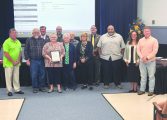Patience occasionally wore thin as the Board went down a several-page list of proposed renovations and space configurations, pausing to debate most of them. Among the proposals were the construction of a “Bunker recreational center” near the golf course, the renovation of the clubhouse, and the expansion of the Ashlawn Grille.
LMOA Board President Marlene Weaver reminded her fellow Board members that their votes that evening were merely to submit the scenarios to an architect for cost estimates – not to approve or deny the ideas themselves.
Director Cole Hunter, who was appointed by the Board to fill the space vacated by Richard Cummings, replied that he felt some of the motions constrained future decisions.
When some of the 17 members in attendance spoke before the Board, most urged caution. “I ask you to heed the community’s plea for moderation as you go forward with your plans,” said Kathryn Renick. Members want buildings they can be proud of, she continued, but not ones that price them out of their homes.
Margaret Ann Webster disliked the potential duplication of services, pointing out that fitness rooms, dog parks, libraries, and restaurants exist already outside the Lake. “We don’t need to live our entire lives within the gates,” she said.
Weaver reminded those in attendance that Lake Monticello residents have to vote before the Board can undertake spending of this kind. “The bottom line is that it’s going to be up to the community in the end,” she said. “Tonight we’re looking at concepts so we can go to the architect and say, ‘This is what we’re considering.’ Any of this can be changed over the coming months.”
In July the Board created the ad hoc committee for renovation/replacement to study the community’s wants and needs for facility renovation and construction as well as preferences as to how to pay for them.
Tom Sullivan, chair of the committee, told the Fluvanna Review that committee members wanted to reach out to Lake Monticello residents in a “very open forum,” so they made use of four town hall-style meetings attended by around 425 people. They also sent out two surveys. One, which received about 1,535 responses, addressed community wants and needs for facilities. The other addressed funding options and received about 960 responses.
“The report was very comprehensive,” Weaver told the Review. “They did above and beyond what we expected them to do. They’re all very interested in seeing this through as far as keeping the community informed during this process… There’s no way in a community this size that we’re going to be able to please everybody. It’s going to be a give and take here and there.”
Funding options include a permanent dues increase, a one-time assessment, borrowing from the LMOA emergency reserve account, or borrowing from a commercial lender.
At the end of the meeting, Board members discussed the next step, which, as Weaver said, is to present the approved motions for cost estimates to the architect. Director Tom Braithwaite decided to publish a summary to keep members informed. Director Bing Spitler wanted a window in which to solicit community comments, be they “good, bad, or ugly.” Weaver urged members to submit their comments via “contact the Board” at lmoavoice.org so that all directors could receive a copy.




